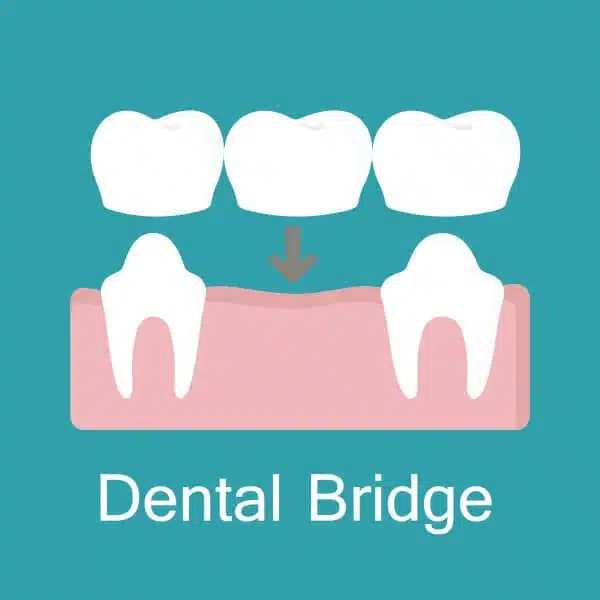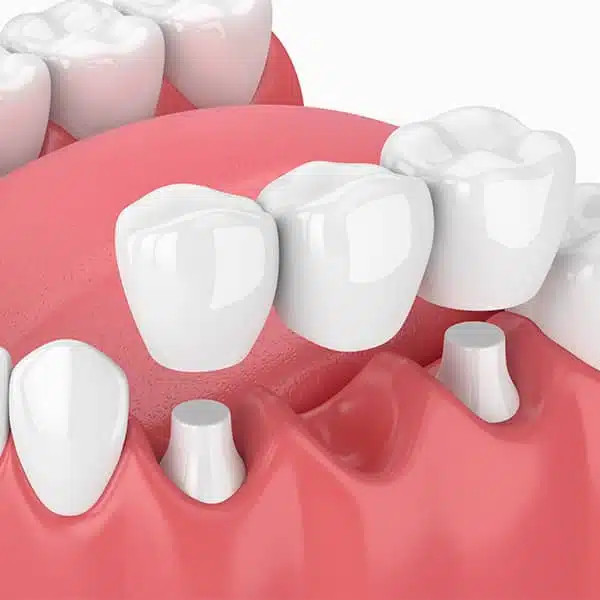Home / Dental Services / Partial and Full Dental Bridges
Partial and Full Dental Bridges in Miami, FL
Dental Bridges Benefits
Dental bridges are a popular and effective solution for replacing missing teeth. They offer numerous benefits that can improve both the appearance and function of your smile.
01
Restore Your Smile and Confidence
With a dental bridge, you can have a beautiful, healthy smile that will boost your self-esteem.
02
Easy Maintenance and Longevity
Dental bridges are easy to care for and last many years with proper maintenance.
03
Enhance Your Oral Health
Bridges fill in gaps between teeth, restoring bite balance and preventing other teeth from shifting out of place. This can help improve your overall oral health.
What Are Dental Bridges?
Dental bridges are created to bridge the gap left by one or more missing teeth or to replace misshapen or discolored teeth. They are constructed using dental crowns that cover the teeth adjacent to the gap (called abutment teeth). The bridge is then used to anchor replacement teeth (known as pontics) in between your natural ones, leaving an organic appearance and a beautiful smile.

What Are Implant-Supported Bridges And Dentures?
If you are missing many teeth, your dentist may recommend an implant-supported full bridge or implant-supported dentures. These replace missing tooth roots, so your bone is better preserved than with conventional dentures. In the long term, implants are appealing, functional, and comfortable replacement options. When properly integrated with your jawbone, dental implants keep the bone healthy and strong.

What Are My Replacement Options?
Although tooth loss is considerably less common than it was decades ago, there are still many reasons why adults may lose teeth, including trauma, advanced gum disease, or extensive tooth decay. The gaps left by these missing teeth can cause the remaining teeth to shift over time, leading to oral health challenges, difficulty speaking and chewing, altered bite, and facial collapse.
Dr. Gallardo will advise you on the best replacement option for your unique situation, which could mean dental bridges, dentures, or implants. His South Florida patients enjoy a range of choices for a natural appearance and effective results.
Types Of Dental Bridges
Dental bridges are classified based on how they attach to your existing teeth.
01
Traditional bridge
In a traditional bridge, the pontic is attached to a crown or a dental implant on either side of the gap.
02
Maryland bonded bridge
In a Maryland bonded bridge, the dentist bonds the bridge to existing teeth using cement or another similar medical product.
03
Cantilever bridge
In a cantilever bridge, the bridge is attached to a tooth on only one side. These are rarely used, as they can put a lot of pressure on the remaining teeth can and cause damage.
Materials Used In Dental Bridges
A dental bridge can be made from a variety of materials
A dental bridge can be made from a variety of materials, including:
- Alloys
- Gold
- Porcelain
- Combination materials
Metal alloys are often the least expensive, but they will look like metal. Gold bridges are pricier and also remain gold-colored, so someone seeking a more natural look may opt for porcelain. It is both more fragile and more expensive than the metal options, but the end result looks like natural teeth.
Types Of Dental Implants
Dr. Gallardo offers several styles of dental implants.
Same-Day Dental Implant
This kind of implant is non-removable and maximizes the use of available bone. Many patients find it surprising that teeth can be attached to the implants the very same day! You can come into our office in the morning and leave in the afternoon ready to smile, laugh, and eat.
Fixed Dental Crown and Bridge
This treatment option is the most like having natural teeth. Your teeth are securely fastened to the implants using cement or precision screws, and the result is non-removable.
Dental Implant bar
This treatment option features clips that attach your dentures to a secure metal bar that provides stability and support. The dentures can still be removed for daily cleaning.
Retained Dental Implant
With this treatment option, your denture snaps securely onto implants via an anchored attachment. The dentures can still be removed for daily cleaning.
Advantages Of Dental Bridges
Dental bridges can also improve your long-term oral health
Chiefly (and obviously), dental bridges close the gap left by missing teeth. With your bridge in place, you can eat, speak, and sing normally and without discomfort. Your dental bridge can also be closely matched to the color of your adjacent teeth, so the average person may not even be able to tell you have a dental bridge.
Dental bridges can also improve your long-term oral health by preventing further decay, shifting teeth, and jawbone erosion.
Dr. Gallardo will customize your dental bridge so that it is precisely fitted to your mouth, and most patients adjust to it quickly and comfortably. Unlike a denture, you do not need to remove the bridge and can care for it by simply brushing regularly.

Advantages Of Implant-Supported Full Bridges And Dentures
Like dental bridges, implant-supported full bridges and dentures can replace missing teeth and improve overall oral health. In addition to looking and functioning like natural teeth, implant-supported full bridges or dentures are designed to be long-lasting and are more comfortable and stable than conventional dentures.
Potential Risks of Dental Bridges
A bridge is supported by healthy adjacent teeth
Typically, a bridge is supported by healthy adjacent teeth on either side of the gap. These teeth may need to be reshaped, however, which can damage them and undermine their structural integrity. Also, if the natural teeth are not strong enough to hold the bridge in place, they may collapse and require dental implants. Additionally, it is very important to brush your teeth thoroughly once a bridge has been placed, as plaque and bacteria can collect between the bridge and crowns.
If you have removable dentures, you must clean them properly each day. Damaged bone beneath bridges or removable partial dentures can lead to facial collapse and unattractive smiles and can make it difficult—even painful—to eat certain foods.
Dr. Gallardo will thoroughly examine your teeth to determine the best replacement option that protects your smile and improves your oral health.
What Implants and Dental Bridges can do?
- Restore the look and functionality of your smile
- Protect your ability to speak, sing, and chew
- Prevent changes to your face shape
- Protect against further jawbone damage
- Keep your remaining teeth in position
- Provide a comfortable, natural-looking tooth replacement
What To Expect From The Dental Bridges Procedure
When you schedule a consultation with Dr. Gallardo, he will review your options and help you choose the best one for your situation. As a specialized periodontist with almost three decades of experience, Dr. Gallardo is adept at placing beautiful, natural-looking dental bridges and implants.
The placement procedure varies based on the type of bridge. With a traditional dental bridge, Dr. Gallardo may reshape your natural teeth to accept the crown or place dental implants for support.
Your dental bridge will be specially crafted to fit your mouth using an impression taken from your teeth and gums. While creating your permanent bridge, Dr. Gallardo will give you a temporary one to wear. When the new, permanent bridge is placed, adjustments will be made to ensure a proper, precise fit. Temporary cement may be used in the procedure to ensure correct placement before permanent installation.
Dental Bridges Recovery
You can use your new dental bridge right away; the recovery period is usually very short. We recommend patients take small bites and choose soft foods to get used to their new bridge. But over time, you will be able to eat not just normally but more easily than before.
Our Work Speaks for Itself
What Our Patients Say
Committed to your results

Why Choose Dr. Gallardo for Your Dental Bridges
- Dr. Gallardo has 30 years of experience offering dental implants and specialized periodontics to patients throughout South Florida.
- Dr. Gallardo is a graduate from the University of Miami and received his Doctor of Dental Surgery degree from New York University College of Dentistry.
- Accepted into the V.A. Medical Center General Practice Residency Program of the U.S Department of Veterans Affairs where he was honored with the “Outstanding Resident of the Year” Award.
- He has lectured nationally and internationally to dentists and hygienists and has been sponsored by companies such as Procter and Gamble to speak on clinical topics related to gum disease and implant dentistry.
- Dr. Gallardo remains a leader in periodontics and implant dentistry through his active and past involvement with University of Florida, Florida Association of Periodontists and North American Society of Periodontists.
Frequently Asked Questions About Dental Bridges
Would a dental bridge be a suitable option for me?
If you are missing one to three teeth in a row, you may be a candidate for a dental bridge. You should have good oral health and be free of gum disease when the bridge is installed, and the supporting teeth should be strong enough to maintain the bridge over time. Your jawbone will need to have sufficient strength and density to receive any dental implants, and if needed, a bone graft may assist with this.
What are the recommended care instructions for a dental bridge after its placement?
After the procedure, Dr. Gallardo and his staff will provide you with detailed information about how to care for your new bridge. In general, you should brush and floss your bridge as you would a natural tooth and take care to protect the anchor teeth on either side. Maintaining good oral hygiene and visiting your dentist regularly will also maintain your dental bridge and prevent further tooth decay.
What is the typical duration of a dental bridge?
With proper care and maintenance, you can expect a dental bridge to last anywhere from five to fifteen years, though most last around ten.
What is the cost of a tooth bridge?
The cost of a tooth bridge can vary significantly depending on the type of bridge, the number and size of teeth involved, and any additional procedures, such as implants, that may be required for proper placement. The total cost for a full dental bridge in a dental office can vary widely. Similarly, a false tooth or temporary bridge also has a variable cost depending on the specific treatment and materials used. To prolong the life of your bridge, it is important to maintain good oral hygiene through regular brushing, flossing, and routine checkups with your periodontist.
At what age is it most suitable to consider getting a dental bridge?
The ideal age for getting a dental bridge is usually over eighteen when the teeth and jawbone have finished developing fully. Getting a bridge before this age could be risky, as the false teeth or temporary bridge may not fit properly and may require additional procedures such as bone grafting for successful placement. It is important to keep in mind that regardless of age, proper care must be taken with brushing and flossing daily as well as regular checkups with your periodontist in order to extend the life of your dental bridge.
Is a dental bridge painful?
No, the procedure to have a dental bridge is not painful. During the procedure, an anesthetic is used to numb the area and ensure comfort for patients. After the procedure, some minor soreness may occur in the mouth but this will usually go away after a few days with proper care and rest.
Do dental bridges provide a sensation similar to that of natural teeth?
Yes, dental bridges can provide a sensation similar to that of natural teeth. With regular dental care and healthy teeth, a custom crown or bridge can be carefully crafted to fit the patient’s mouth like natural teeth. Dentists often use special materials such as porcelain or composite resin to create custom crowns that look and feel just like real teeth. With proper care and regular follow-up visits, bridges can restore your smile for years to come.
Is it possible to remove and reapply a dental bridge?
Removing and reapplying a dental bridge is possible in some cases. This is usually done when a bridge needs to be repositioned due to changes in the gum tissue or where the entire tooth has shifted. However, it is generally not considered an ideal solution for long-term treatment, as it can cause damage to the anchor teeth and decrease long-term stability. Regular tooth cleanings and checkups are essential for maintaining your dental bridge and ensuring that it remains stable over time.
Is it possible to consume food while wearing a dental bridge?
Yes, it is possible to consume food while wearing a dental bridge. If the bridge has been properly fitted and secured by your periodontist, then you should have no problem-consuming soft and hard foods. It is important to take special care when eating, as the bridge may be more vulnerable to chips and cracks if too much force is applied during chewing. Be sure to floss and brush your teeth after every meal in order to maintain the health of your bridge. Additionally, regular checkups with your periodontist are essential for ensuring that your dental bridge remains stable over time.
Am I a good candidate for a Dental Bridge?
If you are missing one to three in a row, you may be a candidate for a dental bridge. You should have good oral health and be free of gum disease when the bridge is installed, and the supporting teeth should be strong enough to maintain the bridge over time. Your jawbone will need to have sufficient strength and density to receive any dental implants, and if needed, a bone graft may assist with this.
What partial and full dental bridges office is near me?
If you live near Miami, Florida, Gallardo Periodontics and Implant Dentistry offers partial and full dental bridges among its services. It is conveniently located at 2020 SW 27th Ave Miami, FL 33145.









